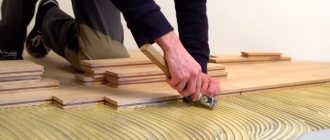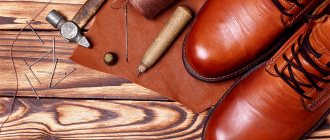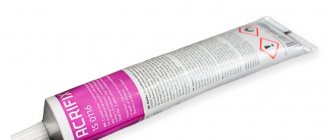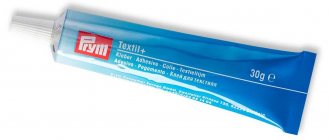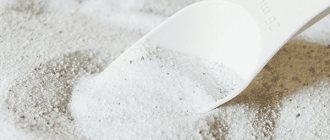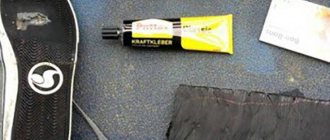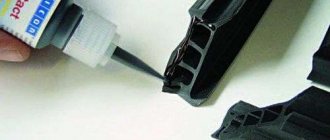If you have a boat made of PVC, then during operation it may require repairs. This need is due to the possible occurrence of holes in the product. If we are talking about a small scratch, then you will need to remove the PVC surface, exposing the fabric. Next, the surface is repaired. Holes and cuts up to five centimeters can be repaired at home or on the go, all you need is a repair kit and some time. If holes have formed, the size of which varies from 5 to 15 cm, you can also eliminate them yourself, but the work will be somewhat more difficult. More significant damage should be dealt with by a specialist.
What glue is best to use for PVC boats?
The glue comes in a repair kit. Quite often, compositions of the Uran or Desmakol brands are used. However, it must be remembered that the first type of mixture can soften when exposed to high temperature, and the patch may peel off. If the contents of the repair kit have been used up, then you will have to choose glue for PVC boats on the building materials market. It is necessary to purchase only those mixtures that are specifically intended for PVC. Consumers should pay attention to two types of glue that are available in stores.
Features of working with the product on a gazelle or truck
If you need to glue a damaged section of an awning on a cargo truck or gazelle, you will need to observe a number of nuances. Before carrying out work, the vehicle must be driven into a garage or other room where the optimum temperature is maintained and there is enough space to access the defect on the canvas.
For convenience, it is better to remove the awning from the car so that you can apply force when fixing the patch and do not have to reach for the damaged areas, but if the design of the vehicle does not allow for the removal of the canvas, then you will have to carry out the work in the existing conditions.
After eliminating the defect, during the drying period of the adhesive solution, it is not allowed to load the awning so as not to break the formed seam.
Polychloroprene adhesive
If there is a need to repair a boat, then you can choose this one-component composition; it is specially designed for gluing inflatable boats, rubberized materials, and wetsuits. Among its positive characteristics are the qualities of water resistance, elasticity and excellent strength. After application, the composition sets quickly enough, and then is characterized by its ability to hold the seam for a long time. Considering the advantages of this composition, it is also necessary to highlight strength, as well as excellent resistance to temperature.
Varieties
To understand what is the best way to glue a PVC boat, it makes sense for the owner of such a watercraft to understand the types of adhesives used for these purposes. All such adhesive compositions are divided into 2 main groups: one-component and two-component. The first ones are usually used for gluing torn off fittings:
- oarlock;
- transom;
- tie rings;
- rubber inserts for seats.
Some of what you may need to glue to the boat
The advantages of one-component compounds are that they are relatively inexpensive and dry quite quickly. The last factor allows them to be used in camping conditions, when parking time is limited. The main disadvantage is that this option is not suitable for repairing the hull of a boat.
Two-part boat adhesives typically cost more. It has a number of advantages over one-component:
- better tolerate temperature changes;
- have greater elasticity;
- create a stronger and more durable bond.
An example of a two-component adhesive: its essence is to mix several components to create one common adhesive mass.
Many two-component compositions are designed specifically for repairing PVC products. With their help, you can repair not only fittings and small holes, but also large damage to cylinders.
Master's recommendations
When choosing glue for PVC, you need to take into account the fact that experts do not recommend using Moment glue, as well as similar compounds. This is due to the fact that the strength and tightness in this case remains questionable. The durability of this material has also not been confirmed. If you still decide to use it, then if you need to apply a new composition, cleaning the surface of the boat will be very problematic. You will most likely have to apply the new mixture to the existing surface. This, of course, significantly reduces the quality of the patch.
How to seal an awning: instructions
You can choose several methods to repair a cut or hole. Actions will depend on the extent of the defect. Read my detailed instructions that will help you easily deal with the problem.
I recommend using a nylon thread to secure the damaged area. It is necessary to degrease the material. It is permissible to use not only acetone, but also alcohol and alcoholic beverages. When the awning is processed, you need to dry it thoroughly.
Glue is applied to the patch and the material is pressed firmly to ensure adhesion. Sometimes a hair dryer is used to warm up the glue, and then the material is rolled on top with a roller.
Canopies at the dacha, already battered by bad weather
It seems easy to make a patch, but in reality it's even easier to make a mistake. If you are going to use a construction heat gun for repairs, then remove it immediately. It is not at all suitable for this purpose.
Some people think that the longer you heat the damaged area, the better. It is not true. If you use a hairdryer on a hole for too long, the material will melt and lose its strength. Work only with those products and tools that are suitable for PVC sheets.
If you take a non-heat-resistant silicone roller, then know that it will not cope with the task completely. By the way, it is necessary to stitch torn parts of the awning. When the edges are not secured, the glued patch will move or come off when exposed to the environment.
Composition of the brand Bostik Vinycol 1520
This glue is made on the basis of polyurethane, to which wax and an organic solvent are added. Application can be done with a brush, and drying occurs quite quickly. After the vulcanization stage, this PVC adhesive will be characterized by high resistance to water and humidity. It is specially designed for repairing inflatable boats.
"Liquid patch"
Russian-made adhesive. The basis is polyvinyl chloride and active reagents. With the help of this glue, both inflatable boats and awnings, swimming pools and other products made of polyvinyl chloride are successfully repaired. According to reviews, “Liquid Patch” is easy to use. Works only on degreased surfaces. It will take at least a day for the glue to dry. The products are available in the following colours: yellow, grey, purple, red and green. Sold in tubes of 20 ml. Price: 200 rubles.
Special properties of Bostik VINYCOL 1520 adhesive
In addition to repairing inflatable boats, this composition does an excellent job of sealing holes in kayaks, catamarans, and rafts. After drying, the composition withstands the effects of waterproofing very well. It can even be used to repair conveyor belts. The lifetime of the composition, which was combined with the second component, is approximately 8 hours.
Film
PVC film is intended for cladding furniture facades, swimming pools, doors and other surfaces. At home, the only possible option is self-adhesive film. To attach such a coating using glue, you need industrial equipment - a vacuum press or a welding machine.
Thus, PVC film adhesive is used on an industrial scale in furniture manufacturing plants or construction organizations. It is selected by specialists based on the purpose, temperature conditions and gluing method. Most often, two-component compositions are used, since they have a higher heat resistance class.
Characteristics of "Vinicola 1520"
If you are thinking about the question of which adhesive for PVC is better, you should consider the characteristics of Vinicola 1520.
The composition has a semi-viscous consistency and a transparent color. During use, you will notice the dominant odor of ketones. Polyurethane acts as an adhesive agent. A mixture of components is used as solvents. Viscosity is approximately 2600 mPa.s. The dry residue makes up about 20% of the mass. Density can vary within 0.82, but this indicator can change in both directions by 0.02. The coverage area is 4 square meters per 1 liter. However, this indicator can be changed depending on the type of material being glued. In order to remove drops of glue from the surface being treated, you should use “Bostik Cleaner M501”. The same composition should be used to clean working tools, as well as equipment. When using the composition, it is necessary to take into account its flammability.
What else can you use?
In addition to the brands listed above, other adhesives are considered quite effective. For example, “RK-2” can be successfully used to work with various types of rubber. The seam is quite elastic and resistant to water and atmospheric influences. For those who are interested in what kind of glue to glue a PVC boat so that the joint is resistant to ultraviolet radiation, we can recommend “UR-mono”.
In addition, this brand is less toxic. Synthetic materials are easily joined with Vinikol-1520 glue. To prevent the seam from coming apart under the influence of an aggressive environment, it is more advisable to use polyurethane glue “900-I”. According to consumer reviews, the connection point will remain intact even if oil, gasoline or acid gets on it.
Heat resistance
If you decide to use the described adhesive for PVC boats for repairs, then you need to know that the composition is able to maintain its characteristics after application under conditions characterized by a thermometer mark of up to +90 degrees. The seam is very resistant to water, oils, gasoline and kerosene. However, it is necessary to ensure that the composition does not constantly come into contact with these substances. As a rule, the adhesive does not change color, and in the case of thin PVC materials, a slight change in shade may still occur under extreme conditions. This also applies to exposure to direct sunlight. If you need to choose the best glue for PVC, then you can prefer the described composition. Consumers are quite often interested in such a characteristic as peel resistance. Twenty-four hours after application at normal ambient temperature, this figure is 10 daN/5 cm. After seven days under the same conditions, the tensile strength doubles.
First gluing method
Surfaces are thoroughly washed and degreased. Acetone is ideal for degreasing - it not only degreases but also slightly dissolves/softens PVC, however, due to its volatility, it does not last long. So, don’t rub it fanatically, otherwise you can wash off the top layer of PVC.
The first layer of glue is applied to the balloon and the patch. Wait 15-20 minutes. The second layer is applied to both surfaces. Wait another 20 minutes to dry. And you don’t have to be afraid that the glue dried in 5 minutes and after 10 it stopped sticking to your finger when you tried it - as soon as you put a patch on the balloon, it will stick and tear it off will be extremely difficult, pellets will form and you will have to Carefully remove the glue and begin the whole process from the beginning. So you need to apply the patch very carefully and without distortions. In general, this pause can easily be extended to 40-50 minutes (I managed to go to the store and buy spare parts for the car). Even if during this time the glue has dried out so much that it has stopped sticking on its own, it’s not scary. We put the patch in place.
And now the most IMPORTANT thing is that you need to press the gluing area well and warm it up to 100-120 degrees for a few minutes. In “stationary” conditions, I use a hair dryer with step-by-step temperature control (10-degree steps from 60 to 600) and a roller for rolling a patch; in outdoor conditions, you can use the bottom m metal mug with boiling water poured into it. Naturally, the gluing site should be on a flat surface (the balloon is deflated); in such conditions, a can from a boat (seat/bench) is perfect for this.
Next, it would be good to wait a day before using it, at least a couple of hours when leaving, and only then inflate it.
With this method, the patch holds quite firmly and if you don’t pump it and don’t overheat it in the sun, it can last for more than one year.
Features of use
If you purchased glue for PVC fabrics, it is important to know how to use it. Only in this case will its composition demonstrate all its best characteristics. Application should be made in an even layer on both surfaces using a brush. For the first coating, it is necessary to allow the glue to dry for ten minutes; for the second coating, the time interval increases to twenty minutes. Do not exceed the maximum open time after application, which is 30 minutes. Once connected, the parts to be glued can no longer be moved. If you use glue for PVC fabric, then during the repair work you need to make sure that air does not get into the adhesive seam.
Tips from the professionals
To properly glue an awning, you need to follow the instructions, use the right tools, and also be aware of the recommendations given by experts. Experts advise the following:
- For the patch, use the same material from which the hanging structure is made. It is also important that its edges are not frayed and that it is dense.
- Do not use tape on the defect site, because such a connection is unreliable. Only special adhesives can properly fix a piece of material at a tear.
- If a person is not sure that he can solve the problem himself, then contact car services. There, the technicians will fix the problem, even if there are large holes in the awning. But this method has one big drawback - the cost of services.
- Sometimes the fabrics come apart at the seams. In such cases, they are not only sewn together with nylon thread, but also an additional adhesive is applied. This allows you to tightly connect the damaged area and avoid repeated ruptures.
- Strictly follow the rules and instructions for sealing the awning on a truck. It is also important to read the information on the glue packaging and not begin work without passing the solvent through the tissue.
You can return the canvas to its normal appearance and eliminate defects so that the awning will serve for a long time with your own hands or with the help of specialists. If the work is done independently, then the main thing is to adhere to the instructions and rules.
When there are large holes in the material or the wear of the awning is too severe, then sometimes it is more prudent to purchase a new awning structure. But if this is not possible, then the defect can be eliminated using one of the solutions and methods described above.
Adhesive installation of polyvinyl chloride pipes
Glue for PVC pipes and fittings is also called cold welding, and not by chance, because it distributes the load, which increases strength and extends the service life of the pipeline to the same extent as it ensures the connection of elements by real welding. PVC pipe adhesive creates a polymer splitting reaction in solvents. After the pipe walls have softened, a fitting with softened walls is attached to them. This process is also called chemical welding.
In this case, it is worth considering one feature. Due to the fact that the chemical properties of additives and solvents vary, the choice of adhesive for PVC pipes must be made taking into account the thermoplastic compounds being welded. As a rule, companies producing plastic pipes offer instructions on the optimal solution to this issue. Be that as it may, it is worth remembering that when joining parts made of chlorinated polyvinyl chloride (CPVC) and regular PVC, you need to use different brands of glue.
The use of glue for PVC sewer pipes is considered a fairly popular method, which ensures excellent tightness of the finished structure.
Remember that uneven coating of pipes with glue or the presence of a large number of irregularities can cause partial glue failure. Complete non-gluing may also occur - this happens when both layers of glue dry out. Please note that you only have a few minutes to complete the connection operation.
The appearance of a soft adhesive layer is caused by a low ambient temperature or by allowing a small amount of time for hardening.
The layer may become porous - this happens when the adhesive layer is enriched with air due to poor mixing of the components.
